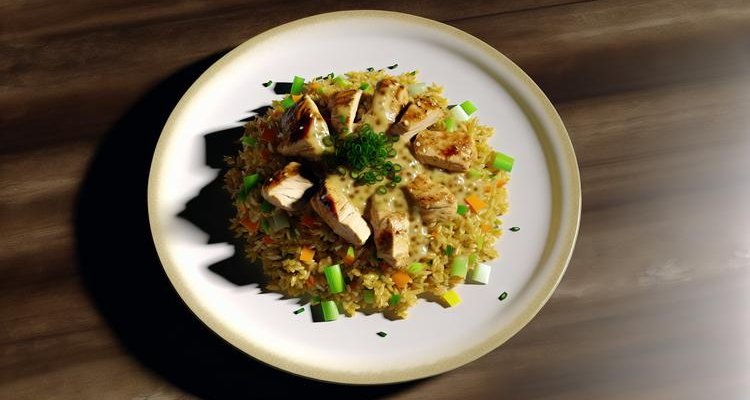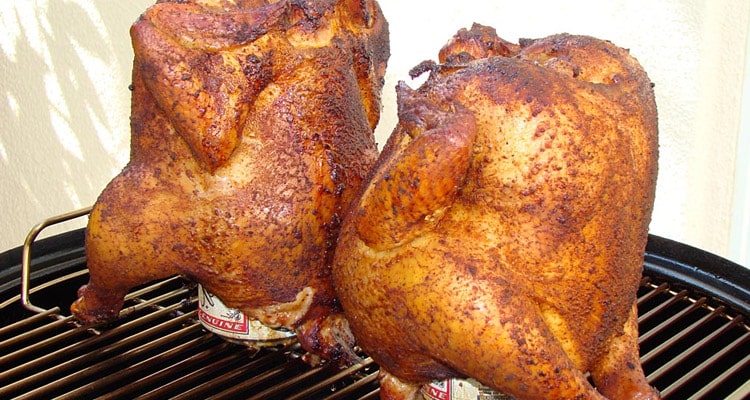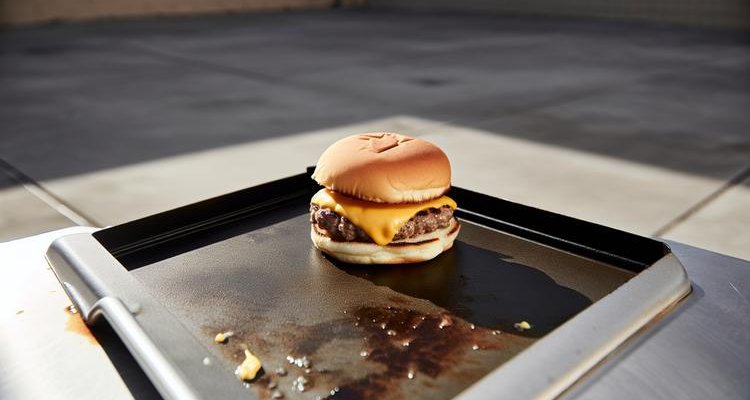
There’s something almost magical about that first bite into a perfectly executed smash burger—the audible crunch of the ultra-thin, caramelized crust giving way to a juicy, beefy interior. While restaurant chains have built empires on this technique, your Blackstone griddle is the secret weapon that brings this experience home. With its massive flat-top surface and incredible heat retention, the Blackstone transforms simple ground beef into burger shop perfection in just minutes.
The smash burger isn’t just another grilling method—it’s a celebration of the Maillard reaction, that beautiful chemical transformation that creates deep, complex flavors through high-heat contact. When you press that beef ball onto a screaming-hot griddle surface, you’re maximizing the contact area where this magic happens. The result? A crust so crispy and flavorful that it rivals any burger joint, all while keeping the interior impossibly juicy.
Why Blackstone Griddles Make the Best Smash Burgers
If you’ve ever wondered why restaurant smash burgers taste different from backyard grill burgers, the answer lies in the cooking surface. Traditional grill grates simply can’t provide the flat, consistent contact needed for that signature crust. The Blackstone’s expansive flat-top surface solves this perfectly, giving you restaurant-level results with these key advantages:
Even Heat Distribution: The thick steel cooking surface retains and distributes heat uniformly, ensuring every burger develops the same perfect crust from edge to edge. No hot spots, no undercooked centers—just consistent perfection.
Maximum Surface Contact: Unlike grill grates that only touch the meat in narrow strips, the Blackstone provides total surface contact. This maximizes the Maillard reaction and creates that signature crispy crust that defines a true smash burger.
Temperature Control: With Blackstone griddle techniques, you can dial in the perfect 400-450°F sweet spot for smash burgers and maintain it throughout cooking. This precise temperature control is what separates good burgers from extraordinary ones.
Choosing the Right Beef and Forming Perfect Balls
Ground chuck with an 80/20 lean-to-fat ratio is non-negotiable for smash burgers. Leaner beef (90/10 or 93/7) will produce dry, cardboard-like patties that defeat the entire purpose. You need that 20% fat content to keep the interior juicy while the exterior crisps to perfection.
For portioning, aim for 2.5 to 3-ounce beef balls—roughly the size of a golf ball. This weight creates patties thin enough to develop maximum crust while staying thick enough to retain juiciness. Form the balls gently without overworking the meat; think of it as loosely packing a snowball rather than compressing clay. Overworked beef becomes dense and tough, while lightly formed balls can expand and spread better when smashed.
Keep your formed beef balls refrigerated until the moment you’re ready to cook. Cold beef sears better and gives you a few extra seconds to perfect your smash before it starts cooking too aggressively.
The Secret to No-Stick Smashing
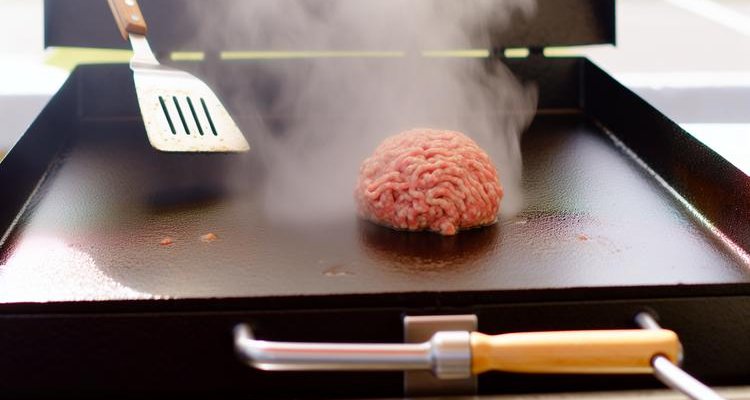
Here’s the game-changing technique that eliminates the frustration of beef sticking to your spatula: the sear-first method. Instead of immediately smashing your beef ball, let it sit on the hot griddle for 30-60 seconds to develop a light sear on the bottom. Then flip it so the seared side faces up, and smash away with confidence. That thin seared crust acts as a barrier, preventing the raw beef from adhering to your press or spatula—no parchment paper needed.
This technique came from testing dozens of smash burgers and watching the raw meat stubbornly stick to every surface imaginable. The sear-first approach changes everything, giving you clean releases every single time while actually improving the final crust development.
Mastering the Smash Technique
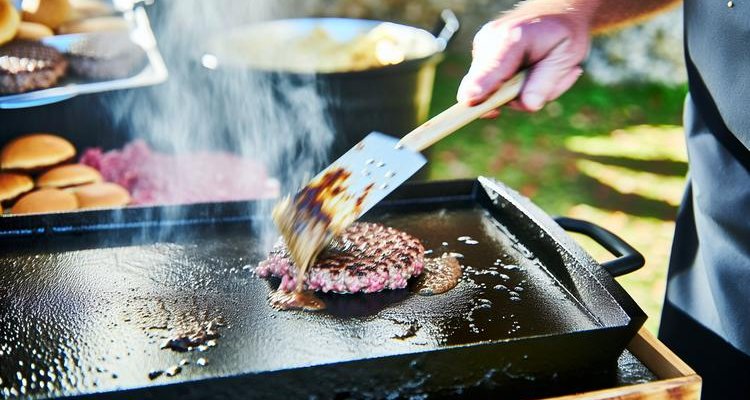
The smash itself requires confidence and commitment—hesitation creates uneven patties. Using a sturdy grill press for smash burgers or two crisscrossed spatulas, press down firmly and steadily for 10-15 seconds until the beef is about ¼-inch thick. You’re not trying to make it paper-thin, but you do want it significantly flatter than a traditional burger patty.
Immediately after smashing, season generously with salt and pepper. The large surface area means you need more seasoning than you’d think, and adding it before smashing can toughen the meat.
Cook the first side for 2-3 minutes without moving it—resist all urges to peek or adjust. This undisturbed contact time is when the crust develops. You’ll know it’s ready to flip when the edges start to brown and curl slightly upward.
Flip once, cook the second side for just 60-90 seconds, then add your cheese. Cover with a melting dome if you have one (highly recommended for quick, even melting without overcooking), or use an inverted metal bowl. The residual heat from the griddle will melt the cheese in 30-60 seconds.
Achieving the Perfect Cheese Melt
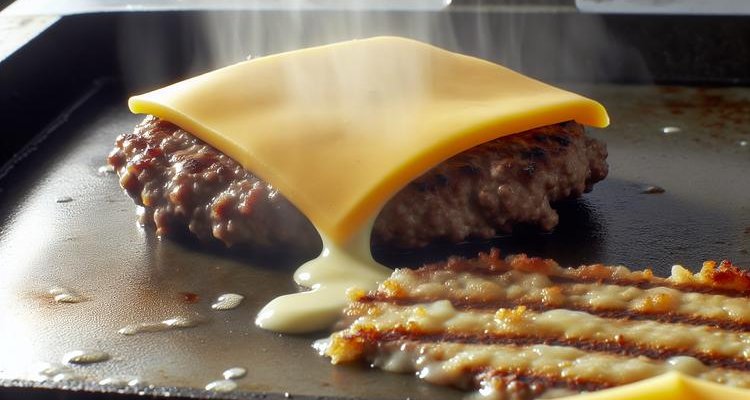
American cheese is the gold standard for smash burgers—it melts quickly, evenly, and creates that classic burger shop drape over the patty edges. Add it during the final minute of cooking to prevent overcooking the beef while waiting for the cheese to melt.
For those who prefer cheddar, sharp cheddar, or pepper jack, the same timing applies, though these cheeses melt slightly slower. The dome technique becomes even more critical with natural cheeses to trap heat and accelerate melting.
Don’t Skip the Bun Toasting
While your cheese melts, use open griddle space to toast your burger buns cut-side down with a thin layer of butter. This takes 60-90 seconds and creates a crispy, golden surface that stands up to burger juices while adding rich, buttery flavor. The contrast between the toasted bun and juicy burger is what separates amateur burgers from professional results.
For more fundamental burger techniques, check out our guide on grilling the perfect burger, which complements these smash burger methods perfectly.
Frequently Asked Questions
What temperature should my Blackstone be for smash burgers?
Preheat your Blackstone to 400-450°F (medium-high heat). This temperature range is hot enough to create rapid Maillard reaction and crust development without burning the exterior before the interior cooks. Use an infrared thermometer to verify your griddle temperature, or test with a few drops of water—they should dance and evaporate within 2-3 seconds at the right temperature.
Can I make smash burgers ahead of time?
Form your beef balls up to 24 hours in advance and refrigerate them on a parchment-lined plate, covered with plastic wrap. However, cook the burgers immediately before serving—smash burgers are best enjoyed fresh off the griddle when the crust is at its crispiest.
What’s the best beef-to-bun ratio for smash burgers?
For standard burger buns, use 2.5-3 ounce beef balls, which create patties roughly 4 inches in diameter after smashing. This size matches typical bun dimensions perfectly. For sliders, reduce to 2-ounce portions.
Do I need parchment paper to prevent sticking?
No parchment paper needed when using the sear-first technique. Let your beef ball sit for 30-60 seconds to develop a light sear, flip it seared-side-up, then smash. The seared crust prevents sticking naturally, making parchment paper unnecessary.
How do I know when my smash burger is done?
Smash burgers cook incredibly fast due to their thinness—usually 2-3 minutes first side, 60-90 seconds second side. The burger is done when the edges are deeply browned and slightly crispy, and the cheese has melted. For food safety, the internal temperature should reach 160°F, though the thin patties typically exceed this easily.
What’s the difference between smash burgers and regular grilled burgers?
Smash burgers are pressed thin on a flat griddle surface to maximize crust development through Maillard reaction, creating an ultra-crispy exterior with a juicy interior. Regular grilled burgers are thicker, cooked on grill grates, and develop char marks instead of a full crust. Smash burgers cook much faster and prioritize crust over thickness.
With these techniques mastered, your Blackstone becomes a smash burger powerhouse, capable of cranking out restaurant-quality burgers that will have your guests wondering what burger shop you ordered from. The combination of proper temperature control, the sear-first technique, and quality 80/20 ground chuck creates results that rival any professional kitchen—all from your backyard griddle.
Blackstone Smash Burger Recipe
Equipment
- Blackstone griddle or flat top grill Preheated to 400-450°F
- Burger press or two sturdy metal spatulas For smashing patties thin
- Cheese melting dome or large metal bowl Optional but recommended for quick cheese melting
- Infrared thermometer For accurate griddle temperature
Ingredients
For the Burgers
- 1 pound ground chuck 80/20 lean-to-fat ratio
- 1 tablespoon neutral oil canola or vegetable oil for griddle
- 1 teaspoon kosher salt for seasoning after smashing
- 1/2 teaspoon black pepper freshly ground
For Assembly
- 4 slices American cheese or cheddar, pepper jack
- 4 burger buns preferably potato or brioche
- 2 tablespoons butter softened, for toasting buns
Optional Toppings
- 4 leaves lettuce iceberg or romaine
- 1 medium tomato sliced
- 1/4 cup sliced pickles dill or bread-and-butter
- 1/4 cup diced onions raw or caramelized
- 1/4 cup special sauce or ketchup your choice
Instructions
- Preheat your Blackstone griddle to 400-450°F (medium-high heat). Test temperature with a few drops of water—they should dance and evaporate within 2-3 seconds.
- Divide ground chuck into 4 equal portions (4 ounces each). Gently form into loose balls without overworking the meat. Refrigerate until ready to cook.
- Lightly oil the hot griddle surface. Place beef balls on griddle and let sit for 30-60 seconds to develop a light sear on the bottom.
- Flip each ball so the seared side faces up. Using a burger press or two crisscrossed spatulas, press down firmly for 10-15 seconds until beef is about ¼-inch thick.
- Immediately season the smashed patties generously with salt and pepper. Do not move or disturb the patties.
- Cook for 2-3 minutes on the first side without touching, until edges brown and crust develops. Resist the urge to peek or adjust.
- Flip burgers once. Cook second side for 60-90 seconds, then immediately add cheese slices on top of each patty.
- Cover patties with a melting dome or inverted metal bowl for 30-60 seconds to melt cheese quickly without overcooking beef.
- While cheese melts, butter the cut sides of burger buns and toast them face-down on the griddle for 60-90 seconds until golden brown.
- Remove burgers from griddle. Assemble on toasted buns with your choice of toppings: lettuce, tomato, pickles, onions, and sauce. Serve immediately.
Notes
- Sear-First Technique: The 30-60 second sear before smashing prevents beef from sticking to your press or spatula—no parchment paper needed.
- Beef Temperature: Keep beef balls refrigerated until cooking. Cold beef sears better and gives you control over smashing before it cooks too fast.
- Don't Overwork the Meat: Form balls gently like packing a loose snowball. Overworked beef becomes dense and tough.
- Griddle Temperature: 400-450°F is critical. Too hot burns the exterior, too cool produces steamed beef without crust.
- One Flip Only: Resist multiple flips. One flip preserves the crust and keeps juices sealed inside.
- Cheese Timing: Add cheese during the final minute to prevent overcooking the thin patties while waiting for melt.
- Bacon Smash Burger: Add 2 crispy bacon strips per burger
- Mushroom Swiss: Top with sautéed mushrooms and Swiss cheese
- Jalapeño Popper Burger: Add sliced jalapeños, cream cheese, and pepper jack
- Oklahoma Onion Burger: Press thin-sliced onions into beef before smashing
Contents

